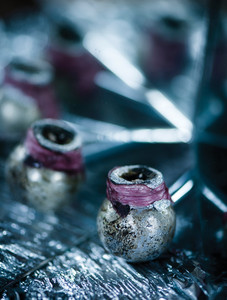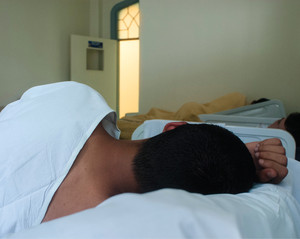
LÉO RAMOS
Metal pipe used to consume crack, a smoked version of cocaineLÉO RAMOSIn 2010, psychologist André Constantino Miguel decided to make a bold move. Selected to enter a doctoral program, he proposed to the team starting to form at the Federal University of São Paulo (Unifesp) that they study a motivational technique in psychology that had not yet been tested in Brazil or used with individuals dependent on crack. He had just returned from two years of study in Italy, where he had worked with people dependent on heroin, and he could not accept the fact that this strategy – contingency management, useful for reducing dependence on alcohol, tobacco and cocaine, according to studies conducted abroad – had still not been implemented in Brazil. That year, he completed his mission by publishing the results of the first study on the use of contingency management as an additional support in the treatment of crack dependency, in the journal Psychology of Addictive Behaviors.
Only recently adopted for the treatment of drug dependency, possibly owing to its controversial nature, contingency management consists of offering financial compensation whenever someone demonstrates behaviors considered desirable.
This strategy, which can be used in a variety of contexts, is based on the work of American psychologist Burrhus Frederic Skinner. In experiments performed on laboratory animals, he demonstrated that the consequences of a given action can shape behavior. For example, rats that received food (consequence) when they pushed a lever (action) tend to repeat the action. In the 1960s, other psychologists adapted contingency management techniques for the treatment of chemical dependence, in which the goal to be achieved is usually abstinence or compliance with the treatment plan.
Someone with a drug dependency who can manage for a period of time not to consume the drug that was holding him hostage receives a reward, usually financial in nature. If he stays clean, he receives vouchers, tickets to concerts, movies or the theater and even cash. It is a simple way to encourage someone to repeat a behavior.

LÉO RAMOS
Specialized attention: people dependent on crack in a detox ward at Cratod…LÉO RAMOSMiguel discovered an opportunity to measure the effectiveness of contingency management in the day-to-day routines of individuals dependent on crack, the smoked version of cocaine, when he was invited to practice at the psychiatric specialty outpatient clinic (AME) at Vila Maria in São Paulo’s north zone. Until then, the technique had been adopted as part of an experimental treatment to increase participation or encourage compliance with therapies for obesity and diabetes or dependency on heroin, alcohol, tobacco and cocaine that was snorted, but not crack.
From August 2012 to July 2014, Miguel and other specialists invited 65 people with crack dependency sent for treatment at AME-Vila Maria to participate in an experiment. Randomly selected, 32 of them received the standard 12-week outpatient treatment. Each participant was given one individual consultation per week with a general clinician, psychologist, psychiatrist, occupational therapist or nurse and could participate in group activities to prevent relapse. These people constituted the control group and were encouraged to collect a urine specimen on Mondays, Wednesdays and Fridays and deliver it to researchers so they could test it for the presence of cocaine or marijuana metabolites.
“Every time the participant received a negative screen for cocaine or crack, his abstinence was validated,” says Miguel. “If the result indicated drugs had been consumed, the group celebrated compliance with the therapy and encouraged him to remain abstinent.”
The remaining 33 participants made up the experimental group, which, in addition to the standard treatment, were subject to contingency management. They were required to go to the AME-Vila Maria three times a week for urine testing for cocaine and marijuana and to submit to a breathalyzer test for alcohol consumption.

LÉO RAMOS
…where they also receive dental careLÉO RAMOSEach time a participant presented a urine sample that was clean for cocaine, he received compensation in the form of a voucher. The voucher for the first negative screen was worth R$5, and the vouchers increased in value by R$2 for each subsequent screen that was clean, up to a maximum amount of R$15 per test. Participants received an additional R$2 if, in addition to abstaining from cocaine use, they had refrained from consuming alcohol. Participants with three negative screens for cocaine in one week received an additional R$20 in the form of a bonus. They were also awarded R$10 if the three urine tests that week were negative for marijuana use. As such, any participant who remained clean for the 12-week period would receive R$942.
In the case of relapse – which is common in the treatment of chemical dependency – the participant would not lose the money he had earned. Instead, with the first positive result, he would receive nothing and the amount of the reward would go back down to the initial amount of R$5 for the next negative screen.
Of the 33 individuals enrolled in the voucher group, 7 (21.2%) did not use crack over the 12 weeks of the study, according to results reported by researchers in the journal Psychology of Addictive Behaviors. No one in the control group remained abstinent over the entire course of the study – only one (3%) remained abstinent from consuming crack for eight weeks, while 9 (27%) of participants who received the financial reward remained abstinent for two months. Those who received the vouchers, in general, also consumed less alcohol and marijuana.
“As they grew in their capacity to remain abstinent and bought into the idea of accumulating the rewards to gain higher levels of compensation, some participants used the vouchers to buy basic goods for their mother or a gift for a child,” says Miguel.

Zanone Fraissat / Folhapress
Consumers and sellers of crack on Alameda Dino Bueno, in downtown São Paulo, where rocks of crack are purchased for amounts ranging from R$5 to R$10Zanone Fraissat / FolhapressAccording to psychologist Clarice Madruga, a professor at the Center for Research on Alcohol and Drugs (Uniad) at Unifesp and coauthor of the study, the willingness to collect more rewards by extending abstinent behaviors indicates that these participants began to tolerate delayed gratification, an ability they had lost when they became dependent. “The consumption of crack and other drugs gives an immediate reward, which may be a fleeting sense of wellbeing or relief to which the body becomes accustomed,” she explains. “New conditioning is needed to extend the period of delayed gratification.”
Six months after the experiment’s completion, researchers offered people in the control group the possibility of working with the contingency management approach. Yet again, around 20% completed the treatment without consuming crack.
Although only a small percentage managed to stay off crack, Miguel points out that this happened under real-life circumstances involving risks that are not in play when subjects are hospitalized. “These people managed to do this even in the eye of the storm, with their rocks of crack alongside them,” emphasizes the researcher, who conducted the study under the supervision of psychiatrist Ronaldo Laranjeira, a specialist in the treatment of alcohol and drug dependency and professor at Unifesp.
The effectiveness of contingency management at different stages of treatment for chemical dependency is recognized today by the National Institute on Drug Abuse (NIDA) in the United States, one of the world’s premier centers for the study of substance abuse, which recommends its use. “Recently, I was at a meeting at NIDA, and no one questions the effectiveness of this technique anymore. It has been adopted in more than 60% of centers for the treatment of alcohol and drug dependency in the United States,” says Laranjeira. “The current debate is about how to implement it properly.”

LÉO RAMOS
Cooking workshop helps to create connections with people who have not yet entered treatment and to train clients of the Helvétia Unit under the Recomeço programLÉO RAMOSContingency management is not itself a treatment method. It is more of a psychological tool intended to encourage the exercise of healthy or desirable behaviors. “This technique could be used on the street as well as in clinics,” says Laranjeira, who coordinates Recomeço [New Beginnings], a program to deal with crack and other drugs begun in 2013 by the government of the state of São Paulo. “I hope that we will soon see these changes in Cracolândia.”
The addiction spiral
Cracolândia is the name given to a few well-known blocks in the neighborhood of Campos Elíseos, in the central area of São Paulo. There, between 600 and 1,000 people, depending on the time of day, smoke crack on the street – purchased on site for between R$5 and R$10. Dirty and dressed in rags, they wander around, often shoeless and with their feet and bodies marked by wounds that do not heal (pain relievers mixed in with the drug block any feeling of pain).
Weakened immunity, a result of their ongoing cocaine use, explains the high number of TB cases among these individuals. Prostitution and unsafe sexual practices in exchange for a few rocks of crack also increase the frequency of sexually-transmitted diseases like syphilis and AIDS, which are more common among people who frequent Cracolândia compared with the population at large.
Crack use surged in Brazil owing to use in this area in the late 1980s, before it spread across the nation. Both the snorted form of cocaine (in powder form) and its smoked form (crack) act in a similar way on the brain: their molecules indirectly increase the concentration of the neurotransmitter dopamine in areas connected to motivation and reward. The result is a sensation of extreme euphoria and wellbeing, which is fleeting nonetheless.

LÉO RAMOS
Conducted twice a day, rehearsals of the percussion group Coração Valente [Brave heart], under the Recomeço program, bring rhythm and structure to the daily life of the chemically dependentLÉO RAMOSIn search of a feeling of wellbeing, users smoke another rock. As time passes, brain cells attempt to return to normal, reducing the amounts of dopamine available. It then becomes necessary to smoke more to attain the same result. With ongoing consumption, cocaine becomes necessary to maintain the levels of dopamine levels to which the body has become accustomed. Without the drug, many unpleasant symptoms ensue: agitation, anxiety, difficulty concentrating, angry outbursts and depression. At this moment, users are no longer smoking for pleasure but rather to avoid suffering.
Young, black and poor
A national survey on drug consumption conducted in 2012 under the supervision of Clarice Madruga and Ronaldo Laranjeira estimated that 1.5% of Brazilians over the age of 14 (almost 2.2 million people) had consumed crack at least once in their lives. A smaller proportion (0.8% or 1.2 million Brazilians) had used the drug in the year prior to the survey, an indication of current consumption. This fact indicates that Brazil has one of the world’s highest number of drug users. In the United States, where cocaine and crack are being replaced by synthetic drugs, current users are 0.3% of the population over the age of 12, or about 8 million people.
Also in 2012, psychiatrist Francisco Inácio Bastos and statistician Neilane Bertoni, both of whom work at the Oswaldo Cruz Foundation (Fiocruz) in Rio de Janeiro, developed a profile of crack users. Researchers went to cracolândias and interviewed 7,300 frequent users of crack distributed over every Brazilian state. They confirmed that these areas are occupied by young and poor black Brazilians: 78% were male, 85% were between 18 and 40 years old, 80% were black or brown-skinned, and 58% were in school only up to the end of middle school. Four out of of ten lived on the street, 65% supported themselves, 10% committed thefts or robberies and 7% engaged in prostitution to get drugs, which they had been using for some time (on average for 6.5 years) and consuming in large quantities (13 rocks a day).

LÉO RAMOS
Under the De Braços Abertos program, the painting, sewing and bicycle repair workshops serve as a space for occupational apprenticeships, and participants earn about R$15 per day for their workLÉO RAMOSTwo programs in the city of São Paulo – Recomeço, run by the state government, and De Braços Abertos [With Open Arms], run by the city government – attempt to help users stop their crack use. Established in 2013, the state program opened the Recomeço Helvétia Unit in mid-2014, as one of the pillars of its outreach work, where researchers intend to adopt the contingency management approach soon. Located in an 11-story building at 55 Alameda Helvétia, the unit offers users access to a social center where they can shower, get their hair cut, have their injured feet cared for, work out and participate in therapeutic cooking and music groups. There is a detox ward on two floors with 21 beds for people who agree to try to quit crack during a hospitalization period. Anyone who is successful at breaking the crack habit can compete for one of 30 spots in one of the supervised apartments located in the same building, and the only requirement for residency is that they remain drug-free. This system of supervision follows a model already adopted in England and the United States, the goal of which is to jumpstart a social reintegration process so that these individuals earn some income and a place to live outside of the crack-infested area.
Before arrival at the Helvétia Unit, individuals from Cracolândia that accept treatment are directed to the Referral Center for Tobacco, Alcohol and Other Drugs (Cratod), facing the Parque da Luz, some 900 meters away. As a center focused on the highly complex, psychosocial dynamics involved with alcohol and drug abuse, Cratod offers therapy groups, dental care, referrals to therapeutic communities and hospitalization. Between April and June 2016, Cratod served about 2,600 crack users referred for different kinds of treatment: 42% for outpatient treatment; 14% for therapeutic communities; and 39% for inpatient detox. “Our centers strive to help the patient navigate the first 90 days of abstinence,” says psychiatrist Marcelo Ribeiro, a professor at Unifesp and Cratod’s technical director.
Food and shelter
Helvétia street, facing the Recomeço building, is home to one of the units of the De Braços Abertos program, opened in early 2014 by the City of São Paulo. Underneath a large metal roof installed over a tract of city land, crack users have access to a bathroom, food and a rest area. It is an entryway, of a sort, for services based exclusively on the principle of harm reduction, which requires nothing in exchange from those who accept the invitation, not even abstinence. “Harm reduction is based on the idea that most people who have a drug problem aren’t able to abstain from using them,” says psychiatrist Leon Garcia, a doctor at the Psychiatry Institute at the University of São Paulo (IPq-USP) and one of the coordinators of health services for the De Braços Abertos program.
In the treatment of chemical dependency, the harm reduction strategy consists of slowly replacing very toxic drugs with less toxic drugs. In the case of crack, however, there is no effective substitute. According to Garcia, this is the reason that De Braços Abertos is counting on offering food, safety and shelter to help those who are dependent to get out of the world of drugs – the Recomeço program, in turn, adopted harm reduction to prevent unintended pregnancies by offering birth control implants.
“Social isolation and extreme poverty precede crack use,” explains psychiatrist Dartiu Xavier da Silveira, who is also a professor at Unifesp, where he has worked for 30 years as coordinator of a chemical dependency treatment program. Considered one of the first to use harm reduction therapy in Brazil, Silveira participated in the early planning of De Braços Abertos. “In Cracolândia, drugs are the result and not the cause of the problem,” he says.
About 500 people currently participate in the city’s program – there is a waiting list of 200 – which offers training workshops in addition to food, living quarters and paid work. Recently, the team at De Braços Abertos conducted a survey designed to assess drug use levels. The data indicate that after six months to one year in the program, 88% of participants had reduced their crack consumption, 85% decreased the use of other drugs, and 83% had begun treatment for other health issues like syphilis and tuberculosis, which are common in these populations. Almost half of participants had also renewed their contact with family members. “When they entered the program, 14% of participants consumed between 80 and 100 rocks of crack per week; today, that number is 2%, and the number of participants who consumed between one and 10 rocks rose from 22% to 47%,” says psychologist Maria Angélica Comis, a municipal drug policy advisor and member of the group coordinating De Braços Abertos’ work.
It would appear that no single approach attains high rates of success, especially when used alone. During his assessment of the contingency management approach, even André Miguel noted that it does not work for everyone. “Around 30% of people who received this type of intervention never turned in a urine sample that was free of cocaine,” he says.
The effects of this approach also seem to be time limited. A meta-analysis (which combines the data from various research studies) of contingency management used to treat cocaine dependence suggests that three months after the treatment is completed, 67% of subjects are back to taking the drug. One way to extend the period of abstinence would be to lengthen the contingency management treatment period, which, in addition to encouraging abstinence, can also be a way to promote reconnection with family and treatment compliance. This is the strategy Canada uses with people dependent on heroin. “The initial phase of escaping dependency can generate a lot of frustration because of the amount of harm to be repaired,” says Clarice Madruga.
 LÉO RAMOSAnyone researching chemical dependency and ways to prevent it knows that, as a rule, treatment requires multiple approaches to be effective and produce sustainable results. “Ideally, several strategies should be employed,” explains psychiatrist Frederico Duarte Garcia, coordinator or the Drug Reference Center at the Federal University of Minas Gerais (UFMG). “At the outset, you need to connect with the person who is drug dependent and motivate him to enter the treatment chain.” Treatment can include measures that range from harm reduction to hospitalization, in addition to participating in groups like Alcoholics Anonymous (AA) and Narcotics Anonymous (NA). “The goal,” says the UFMG researcher, “should be to rebuild the individual’s life between relapses and encourage his reintegration into society.”
LÉO RAMOSAnyone researching chemical dependency and ways to prevent it knows that, as a rule, treatment requires multiple approaches to be effective and produce sustainable results. “Ideally, several strategies should be employed,” explains psychiatrist Frederico Duarte Garcia, coordinator or the Drug Reference Center at the Federal University of Minas Gerais (UFMG). “At the outset, you need to connect with the person who is drug dependent and motivate him to enter the treatment chain.” Treatment can include measures that range from harm reduction to hospitalization, in addition to participating in groups like Alcoholics Anonymous (AA) and Narcotics Anonymous (NA). “The goal,” says the UFMG researcher, “should be to rebuild the individual’s life between relapses and encourage his reintegration into society.”
Projects
1. Evaluating the efficacy of contingency management in a standard open treatment facility for individuals with crack dependence disorder (nº 2013/04138-7); Grant Mechanism Scholarships in Brazil – Fast-track Doctorate; Grantee André de Queiroz Constantino Miguel; Principal Investigator Ronaldo Ramos Laranjeira (Unifesp); Investment R$93.378,54.
2. Evaluating the efficacy of contingency management in a standard open treatment facility for individuals with crack dependence disorder (nº 2011/01469-7); Grant Mechanism Regular Research Grant; Principal Investigator Ronaldo Ramos Laranjeira (Unifesp); Investment R$80.870,99.
Scientific Articles
MIGUEL, A. Q. et al. Contingency management is effective in promoting abstinence and retention in treatment among crack cocaine users in Brazil: A randomized controlled trial. Psychology of Addictive Behaviors. V. 30 (5). p. 536-43. August 2016.
ABDALLA, R. et al. Prevalence of cocaine use in Brazil: Data from the II Brazilian National Alcohol and Drugs Survey. Addictive Behaviors. 2014.
BASTOS, F. I. and BERTONI, N. (ed.). Pesquisa nacional sobre o uso de crack. Rio de Janeiro: Editora ICICT/Fiocruz. 2014.